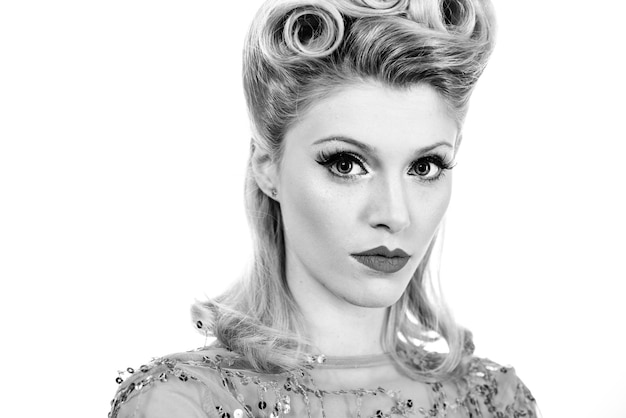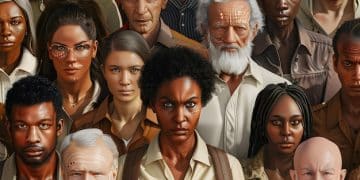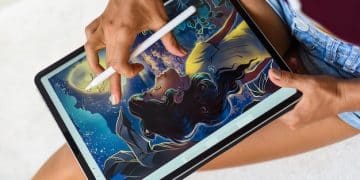The Evolution of American Humor: A Hilarious Look at What’s Funny in the US Today

The Evolution of American Humor: What’s Funny Now and Why? explores how humor in the United States has changed over time, influenced by social, political, and cultural shifts, and examines the current trends shaping comedic preferences.
American humor is a constantly shifting landscape, reflecting our ever-evolving society. To truly understand what tickles our funny bones today, we need to explore the evolution of American humor: what’s funny now and why?
The Roots of American Comedy
American comedy didn’t spring from nowhere. It has deep roots in various cultural traditions and historical moments. From early minstrel shows (though problematic) to sophisticated vaudeville acts, the seeds of American humor were sown in diverse soils.
Early Influences on American Humor
The very first forms of American humor were built upon storytelling, satire, and making light of everyday hardships. This approach laid the foundation for much of what would follow.
Vaudeville and the Rise of Mass Entertainment
Vaudeville brought a diverse range of comedic styles to the forefront, from slapstick to witty banter. It also made comedy more accessible to wider audiences, democratizing humor in a way that hadn’t been done before.
- Minstrel shows, though controversial, initially provided spaces for marginalized voices to participate in the comedic arts.
- The rise of Vaudeville democratized entertainment, uniting disparate communities through shared laughter.
- Early comedic forms created enduring characters and archetypes that still influence modern humor.
Early American comedy was a melting pot, drawing from many different forms of expression and entertainment. It established archetypes and comedic forms that still influence humor today.
The Golden Age of Radio and Television
The advent of radio and television brought comedy into the homes of millions of Americans, leading to the “Golden Age” of comedic programming. Shows like *I Love Lucy* and *The Jack Benny Program* set a new standard for comedy and established sitcoms as a dominant form.

Sitcoms and Family-Friendly Humor
Sitcoms quickly became a staple of American television, offering viewers a chance to escape into the lives of relatable characters and laugh at their everyday struggles. This ushered in an era of more sanitized family-friendly humor.
The Rise of Stand-Up Comedy
Stand-up comedy also started to gain prominence, with legendary figures like Bob Hope and Milton Berle captivating audiences with their wit and observational humor. Television offered them a platform to reach wider audiences.
- Radio and television made comedic talent accessible to a nationwide audience.
- The sitcom format provided a consistent, character-driven source of humor.
- Stand-up comedy evolved from vaudeville roots into a popular, individualized art form.
The Golden Age of TV and radio broadened comedy’s appeal, cementing sitcoms and stand-up as fundamental components of American entertainment.
Counterculture Comedy and Social Commentary
As American society underwent profound changes in the 1960s and 70s, comedy began to reflect the shifting cultural landscape. Counterculture comedians like George Carlin and Richard Pryor challenged norms and used humor to address social and political issues.
Breaking Boundaries with Satire
Comedians started to push the boundaries of what was considered acceptable, using satire to critique institutions and challenge societal norms. They explored controversial topics that were once off-limits.
The Influence of *Saturday Night Live*
*Saturday Night Live* emerged as a groundbreaking force, blending sketch comedy with political satire. The show provided a platform for new comedic voices and became a cultural touchstone.
- Comedy shifted towards addressing social and political issues more directly.
- Satire became a popular tool for critiquing power structures and challenging conventional wisdom.
- SNL played a crucial role in shaping the comedic landscape and launching new comedic stars.
Social upheaval in the 60s and 70s inspired a new wave of comedy that tackled difficult issues, paving the way for more honest and provocative comedic expression.
The Digital Age and the Democratization of Humor
The internet and social media have revolutionized the way we consume and create comedy. Anyone with a smartphone can become a content creator, leading to a proliferation of diverse voices and comedic styles. Memes, viral videos, and podcasts have become powerful forces in shaping contemporary humor.
The Rise of Internet Comedy
The internet has allowed for the rise of new comedic forms and formats. Web series, sketches, and comedic podcasts have attracted large audiences, offering alternative avenues for comedic expression.
Memes and Shared Laughter
Memes have become a universal language, providing a quick and easily shareable form of humor. They reflect current events, inside jokes, and relatable everyday experiences.

- The internet platformed individuals, democratizing comedy and lowering barriers to entry.
- Memes have facilitated mass participation in humor, making it more conversational
- Online platforms now function as both generators and distributors of mass comedic content.
The digital age has completely transformed comedy, providing new platforms, formats, and voices that never would have had a chance before.
Current Trends in American Humor
So, what’s funny now? Today, irony, absurdity, and self-deprecating humor reign supreme. Comedians are increasingly tackling sensitive topics with nuance and exploring the complexities of identity. The focus is on authenticity and relatability.
The Power of Irony and Absurdity
Post-modern irony and absurdism allow performers and writers to engage with increasingly complex social dynamics that are not easily represented by other means. The goal is not necessarily laughs, but astute observations.
Comedy and Identity Politics
Comedy is often used today as a tool for empowering marginalized voices and exploring issues of race, gender, sexuality, and class. This allows for nuanced conversations and cathartic laughter.
- Subversive and self-deprecating humor is popular, highlighting authenticity and vulnerability.
- Comedians are engaging with potentially ‘offensive’ subjects while promoting empathy.
- Diverse representation matters, influencing comedic approaches and what’s celebrated.
Modern trends show an increasing demand for comedy that is both funny and socially aware, embracing diverse voices and tackling sensitive topics with nuance.
The Future of American Humor
Predicting the future of comedy is like predicting the future of society itself. However, several trends suggest that humor will become even more personalized, interactive, and globally connected. Technology will play an increasingly important role, blurring the lines between reality and satire.
Virtual Reality and Immersive Comedy
Imagine experiencing comedy in a virtual environment, interacting with characters and becoming part of the joke. VR and AR technologies hold immense potential for creating immersive comedic experiences.
AI and the Automation of Humor
Could AI one day write jokes? While it may be a distant possibility, AI is already being used to analyze and understand humor. As AI evolves, it could potentially assist comedians in generating ideas and crafting punchlines.
- Technology may allow comedy to transform into an extremely personalized experience.
The future looks bright and full of possibilities, as AI and VR technologies continue to evolve the American sense of humor.
| Key Point | Brief Description |
|---|---|
| 🎭 Early Humor | Storytelling and Vaudeville set the stage. |
| 📺 TV’s Golden Age | Sitcoms and stand-up became household staples. |
| 🗣️ Social Commentary | Comedy addressed social and political issues. |
| 🌐 Digital Revolution | Internet, memes, and democratization of humor. |
Frequently Asked Questions
▼
American humor has evolved from simple storytelling and vaudeville to incorporating social commentary and internet memes, always reflecting the changing cultural landscape.
▼
Television brought comedy into homes, popularizing sitcoms and stand-up, making humor more accessible to millions while establishing new comedic formats.
▼
Counterculture movements made comedy more socially and politically aware, breaking boundaries and challenging norms through satire and provocative content.
▼
The internet democratized humor, allowing anyone to create and share content, leading to the rise of memes, viral videos, and diverse comedic voices online.
▼
Current trends include irony, absurdity, self-deprecating humor, and comedy that engages with social issues while emphasizing authenticity and relatable experiences.
Conclusion
From vaudeville stages to viral memes, the evolution of American humor has been a wild and laughter-filled ride, and it has never been more complex than it is today. As our culture continues to evolve, you can bet that American humor will keep on laughing along the way.





